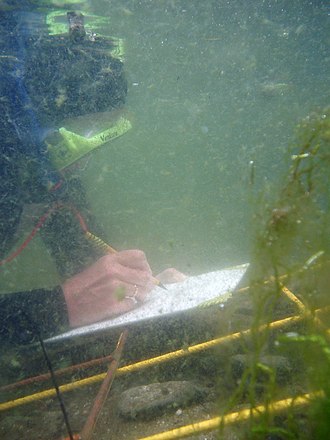Underwater archaeology
| Advanced search |
- About 23 results found and you can help!
Underwater archaeology is archaeology practised underwater. As with all other branches of archaeology it evolved from its roots in pre-history and in the classical era to include sites from the historical and industrial eras. Its acceptance has been a relatively late development due to the difficulties of accessing and working underwater sites, and because the application of archaeology to underwater sites initially emerged from the skills and tools developed by shipwreck salvagers..</ref> As a result underwater archaeology initially struggled to establish itself as bona fide archaeological research. The situation changed when universities began teaching the subject and when a theoretical and practical base for the sub-discipline was firmly established. Underwater Archaeology now has a number of branches including, after it became broadly accepted in the late 1980s maritime archaeology: the scientifically based study of past human life, behaviours and cultures and their activities in, on, around and (lately) under the sea, estuaries and rivers. This is most often effected using the physical remains found in, around or under salt or fresh water or buried beneath water-logged sediment. In recent years the study of submerged WWII sites and of submerged aircraft in the form of underwater aviation archaeology have also emerged as bona fide activity.
- Related: Aerial archaeology, Archaeology of shipwrecks, Aviation archaeology, Maritime archaeology, Nautical Archaeology Society, Sonar, Underwater acoustics, Underwater Archaeology Centre, Underwater search and recovery, Wreck diving
| Underwater Archaeological Field School in a Roman ... Underwater Archaeological Field School in a Roman portuary city. Menorca. Spain www.ecomuseodecavalleria.com/en/aquaescuela.asp - Web |
| RPM Nautical Foundation RPM Nautical Foundation www.rpmnautical.org - Web |
| Institute of Maritime History Institute of Maritime History www.maritimehistory.org - Web |
Gallery for «Underwater archaeology»
- Uluburun shipwreck nude.jpg
Average relevance
| Institute of Nautical Archaeology Institute of Nautical Archaeology ina.tamu.edu - Web |
| Lighthouse Archaeological Maritime Program (LAMP),... Lighthouse Archaeological Maritime Program (LAMP), St. Augustine, Florida www.LAMPmaritime.org - Web |
| Centre for Historical and Maritime Archaeology, Un... Centre for Historical and Maritime Archaeology, University of Bristol www.bris.ac.uk/archanth/postgrad/maritime.html/ - Web |
| Centre for Maritime Archaeology University of Sout... Centre for Maritime Archaeology University of Southampton www.cma.soton.ac.uk - Web |
| Centre for Maritime Archaeology, University of Uls... Centre for Maritime Archaeology, University of Ulster, Coleraine www.science.ulster.ac.uk/cma/ - Web |
| Capitalism versus Socialism in Underwater Archaeol... Capitalism versus Socialism in Underwater Archaeology www.shipwrecks.com/ethics_in_underwater_archaeology.htm - Web |
| A Code of Ethics for Maritime Archaeologists by Au... A Code of Ethics for Maritime Archaeologists by Australian AIMA www.aima.iinet.net.au/home/aimaethic.html - Web |
| East Carolina University Maritime Studies East Carolina University Maritime Studies www.ecu.edu/maritime/ - Web |
Low relevance
| Flinders University Maritime Archaeology Program Flinders University Maritime Archaeology Program ehlt.flinders.edu.au/archaeology/welcome/maritime.php - Web |
| Maritime Archeology in Israel Maritime Archeology in Israel tauac.typepad.com/ac/2007/05/tau_researchers.html - Web |
| The Museum of Underwater Archaeology (MUA) The Museum of Underwater Archaeology (MUA) www.uri.edu/mua - Web |
| National Park Service Submerged Resources Center National Park Service Submerged Resources Center www.nps.gov/submerged - Web |
| Nordic Underwater Archaeology Nordic Underwater Archaeology www.abc.se/~pa/uwa/ - Web |
| Resources for maritime archaeologists Resources for maritime archaeologists gmsbc.blogspot.com - Web |
| "Shipwrecks" in Stillwell, Richard, William L. Ma... "Shipwrecks" in Stillwell, Richard, William L. MacDonald, Marian Holland McAllister, eds. Princeton Encyclopedia of Classical Sites, 1976, Includes alphabetized list of known wreck sites from Classical Antiquity. vanth.perseus.tufts.edu/.../ptext?doc=Perseus%3Atext%3A1999.04.0006%3Aid%3Dshipwrecks - Web |
| Submerged Cultural Resources Laws Submerged Cultural Resources Laws www.nps.gov/history/archeology/sites/stateSubmerged/index.htm - Web |
| Submerged Landscapes Archaeological Network Submerged Landscapes Archaeological Network www.science.ulster.ac.uk/cma/slan/ - Web |
| University of Southern Denmark Maritime Archaeolog... University of Southern Denmark Maritime Archaeology Program www.sdu.dk/maritimearchaeology - Web |
| Oxford Center for Maritime Archaeology Oxford Center for Maritime Archaeology www.arch.ox.ac.uk/ocma.html/ - Web |
| Institut Européen d'Archéologie Sous-Marine Institut Européen d'Archéologie Sous-Marine www.ieasm.org - Web |

